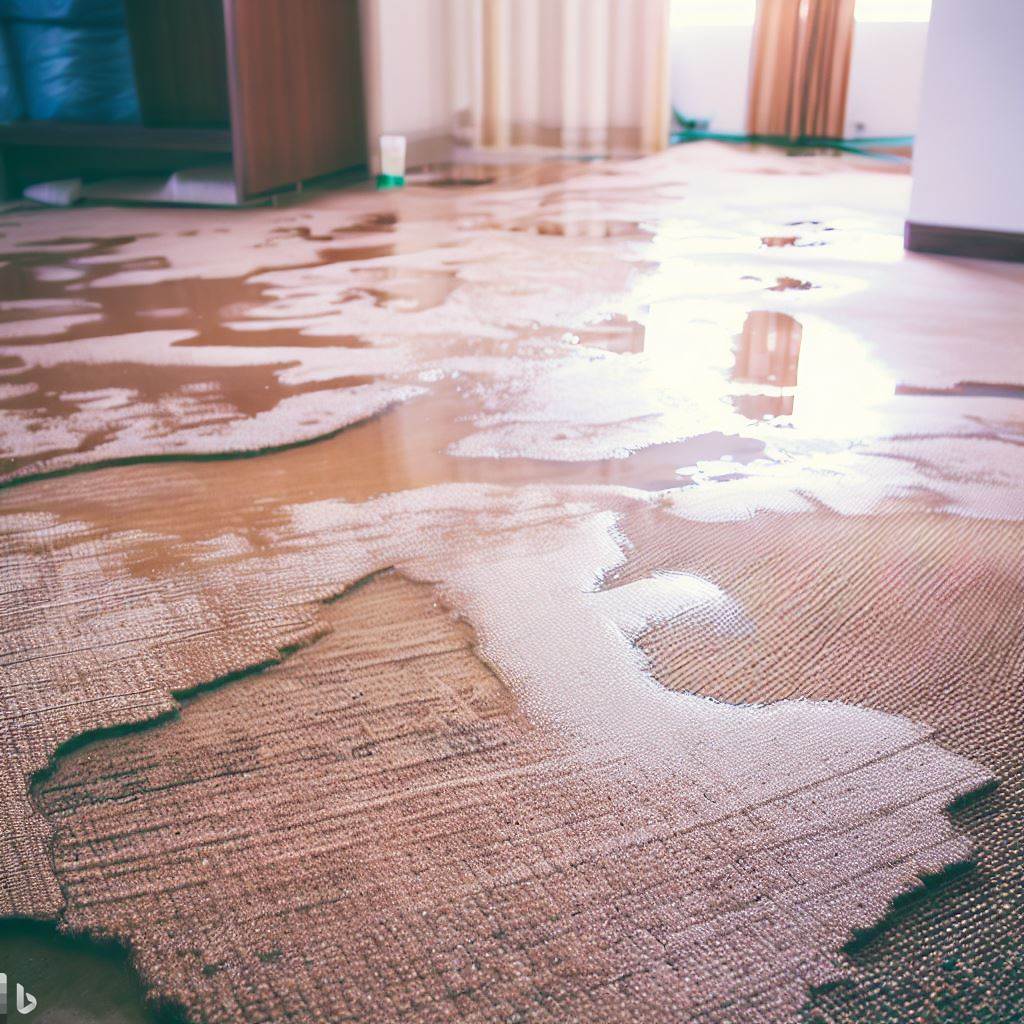Water damage can be a homeowner's worst nightmare. Whether caused by heavy rain, plumbing failures, or other unforeseen circumstances, water damage can result in significant property damage and expensive repairs. However, there are effective water damage prevention tips you can implement to ensure the safety of your home.
By following these tips, you can protect your property, prevent water damage, and ultimately enjoy peace of mind knowing that your home is safe and well-maintained. Read on to discover effective water damage prevention tips that can help safeguard your home.
By following these simple steps, you can maintain and inspect your roof to prevent water damage to your home.
Installing a sump pump and backup system is a proactive measure you can take to prevent water damage and protect your property.
Key Takeaways:
- Regular roof inspections and maintenance can prevent water damage.
- Clean and maintain gutters and downspouts to direct rainwater away from your home's foundation.
- Installing a sump pump and backup system can provide extra protection against water damage caused by heavy rainfall or plumbing failures.
- Sealing and waterproofing your home's exterior walls and foundation can prevent water infiltration.
- Regularly inspect and maintain your plumbing systems to prevent leaks and water damage.
Inspect and Maintain Your Roof Regularly
To prevent water damage, it's essential to inspect and maintain your roof regularly. Check your roof for any signs of damage or deterioration, such as missing, cracked, or curled shingles, or leaks. If you notice any issues, address them promptly to prevent further damage. Regular maintenance, such as cleaning debris from your roof, can prevent water from seeping into your home, causing extensive water damage. Here's a table outlining some of the crucial steps to inspect and maintain your roof:| Step | Description |
|---|---|
| Inspect your roof | Look for signs of damage or deterioration such as missing shingles, leaks, cracks, and curled shingles. |
| Clean debris from your roof | Remove any debris, such as leaves, branches, or dirt, to prevent water from pooling and causing water damage. |
| Replace damaged shingles or tiles | Address any damage by replacing or repairing shingles or tiles. |
| Trim overhanging branches | Trim any branches that are touching or close to your roof to prevent damage from falling branches or leaves. |
| Check flashing and seals | Check for any cracks or gaps in your roof's seals or flashing and repair as necessary. |
Maintain and Clean Gutters and Downspouts
Proper maintenance and cleaning of your gutters and downspouts are crucial for preventing water damage to your home. Leaves, twigs, and other debris can accumulate in your gutters and cause blockages, preventing water from flowing through your downspouts. This can result in water overflowing and potentially causing damage to your roof, walls, and foundation. To prevent this from happening, you should maintain and clean your gutters and downspouts regularly. Here are some tips to help you:- Schedule regular gutter and downspout cleaning at least twice a year, preferably in the spring and fall.
- Use a sturdy ladder to access your gutters and wear appropriate safety gear, such as gloves and eye protection.
- Remove large debris using a scoop or trowel, and use a garden hose to flush out any remaining dirt and small debris.
- Ensure that your downspouts are properly installed and aimed away from your home's foundation to direct rainwater away from your home.
Install a Sump Pump and Backup System
If you live in an area prone to heavy rainfall, a sump pump is a valuable investment to prevent water damage. A sump pump is a device installed in a basement or crawl space that removes water that has accumulated in a sump pit. This prevents flooding and water damage to your property. However, power outages can occur during severe weather, rendering your sump pump useless. This is where a backup system comes in handy. A backup system will ensure that your sump pump continues to function during power outages, providing continuous protection against water damage. There are two types of backup systems available:| Backup System Type | Description |
|---|---|
| Battery Backup | This system will keep your sump pump running for several hours after a power outage. It is a good option if power outages in your area are infrequent and short-lived. |
| Water-Powered Backup | This system uses your home's water supply to power the sump pump. It is an excellent option if power outages in your area are frequent or prolonged, as it does not rely on electricity. |
Seal and Waterproof Exterior Walls and Foundation
Properly sealing and waterproofing your home's exterior walls and foundation can prevent water infiltration. Apply weatherproofing sealant to any cracks or gaps in your walls and ensure your foundation is properly waterproofed. This will help prevent water from seeping into your home, reducing the risk of water damage. Some common areas where water can seep into your home include:- Foundation walls
- Window sills
- Door thresholds
- Vents and other openings
| Benefits of Properly Sealing and Waterproofing Your Home's Exterior | Risks of Not Sealing and Waterproofing Your Home's Exterior |
|---|---|
| Prevents water infiltration, reducing the risk of water damage | Increased risk of water damage to your home's foundation, walls, and interior |
| Improves overall energy efficiency by reducing drafts and air leaks | Increased energy costs due to heating and cooling inefficiencies |
| Enhances indoor air quality by preventing mold and mildew growth | Increased risk of mold and mildew growth, which can cause respiratory issues and other health problems |
Maintain Plumbing Systems and Fix Leaks Promptly
Regularly maintaining your plumbing systems is essential for preventing water damage in your home. By taking proactive measures, you can avoid potential leaks that can lead to costly repairs and extensive damage. One of the most critical steps in maintaining your plumbing systems is to regularly check for leaks. Even a small leak can lead to significant water damage over time. Check for signs of leaks, such as water stains or damp areas around pipes or fixtures, and address them as soon as possible. Promptly fixing leaks can prevent more significant problems down the road. Another important aspect of maintaining your plumbing systems is to check pipe connections regularly. Over time, connections can loosen or deteriorate, leading to leaks or pipe bursts. By monitoring these connections, you can catch potential problems before they become major issues. It's also crucial to keep your plumbing systems clean and clear of debris. Over time, clogs and buildups can occur, leading to slow drains and backups that can cause water damage. Regularly cleaning out your drains and keeping them clear can prevent these issues from occurring. By taking these steps to maintain your plumbing systems and promptly fixing any issues, you can prevent water damage in your home and avoid costly repairs. Don't neglect your plumbing systems - keep them in top shape to protect your home and ensure your peace of mind.Conclusion
Protecting your home from water damage is crucial for maintaining its safety and longevity. By implementing these essential water damage prevention tips, you can safeguard your property and enjoy peace of mind. Regularly inspecting and maintaining your roof, gutters, plumbing systems, and foundation is vital for preventing water damage. Additionally, consider installing a sump pump and backup system to provide an extra layer of protection during heavy rainfall or plumbing failures. Sealing and waterproofing your home's exterior walls and foundation can also prevent water infiltration. Apply weatherproofing sealant and address any cracks or gaps to reduce the risk of water damage. Remember to act promptly if you notice any signs of water damage, such as dampness or water stains. Regular maintenance and proactive measures are essential for protecting your home from potential water damage.FAQ
What are some effective water damage prevention tips for home safety?
Some effective water damage prevention tips for home safety include inspecting and maintaining your roof regularly, maintaining and cleaning gutters and downspouts, installing a sump pump and backup system, sealing and waterproofing exterior walls and foundation, and maintaining plumbing systems and fixing leaks promptly.
Why is it important to inspect and maintain your roof regularly?
Regular roof inspections and maintenance are crucial for preventing water damage. Checking for any signs of damage or deterioration, such as missing shingles or leaks, and promptly addressing them can prevent water from seeping into your home and causing extensive damage.
How can I maintain and clean my gutters and downspouts?
Proper gutter and downspout maintenance involves regularly cleaning out debris, leaves, and other blockages to ensure proper water flow. By directing rainwater away from your home's foundation, you can prevent water from pooling near the foundation and potentially causing water damage.
Should I consider installing a sump pump and backup system?
Yes, installing a sump pump in your basement or low-lying areas can help prevent water damage caused by heavy rainfall or plumbing failures. Additionally, installing a backup system ensures that the pump continues to function even during power outages, providing an extra layer of protection against water damage.
How can I seal and waterproof exterior walls and foundation?
To seal and waterproof your home's exterior walls and foundation, apply weatherproofing sealant to any cracks or gaps in the walls and ensure the foundation is properly waterproofed. This will prevent water from seeping into your home and reduce the risk of water damage.
Why is it important to maintain plumbing systems and fix leaks promptly?
Regularly inspecting and maintaining your plumbing systems helps prevent leaks and water damage. By checking for signs of leaks and addressing them promptly, such as dampness or water stains, you can reduce the risk of plumbing-related water damage.
How can following these water damage prevention tips benefit my home?
By following these effective water damage prevention tips, you can safeguard your home from potential water damage. Regular inspections, maintenance, and proactive measures will help ensure your home's safety and longevity. Implementing these strategies will provide peace of mind knowing that you have taken the necessary steps to prevent water damage.





